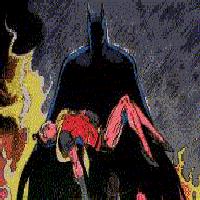
In 1988, another Batman story line made comic history. This story
line was called "A Death in the Family." In this issue the second
character to be called Robin was killed. This book is important
because Robin's fate was decided by the fans. At the end of the third
part of this series, Robin was blown up by a bomb set by the
Joker. At this time fans were asked to call in and vote for
Robin's life or death. The actual vote was 5343 to 5271; a mere 72
votes killed off the Boy Wonder. Later, a third character (Timothy
Drake) was created to fill the Robin role.
The CCA got new guidelines in 1989. They are the latest version of the
guidelines, so when you read a comic book today with a CCA seal these are
the standards it had to meet to carry the seal. When comparing this document with the 1954 and 1971 versions you'll
notice a drastic change!
In 1989, the "Batman" movie came out, and was a smash hit. The
movie would help boost comic books to a new-found popularity that hadn't
been seen since the Marvel Age. But it wasn't just the movie that made
comics popular again, it was also older readers. Collecting comics was
usually seen as a kids thing, something that teen-agers or adults shouldn't
be doing. But the 80's changed that. Comics became more adult-oriented, they
dealt more with mature issues while keeping the comic fun without being too
corny. This resulted in a shift in the age of comic collectors. Those who
read comics as a kid, kept reading them or returned to reading them. Today
comics are not just for kids (some are not for kids period), the average
comic reader today is between the ages of 15 and 23. About 30% of the
consumers are over 20 years old. This, along with the new influx of
Batman-inspired fans, made comics more popular for a few years.
As well, there was the "speculator" market. This market was comprised of people who bought several copies of a certain comic issue, with the intent of re-selling them later at a higher price, if the demand for the issue was higher than the stores could satisfy. The speculator market would play a big factor in the entire comic market's future success and downfall.

Also in 1989, Sandman #1 came out. This book was different than
any other superhero comic book. It was so unique, I have trouble calling it
a superhero book. The main character, Morpheus, also known as The
Sandman, was a supernatural being with powers. He wasn't really a hero but
instead a deity that was the God of the Dreamworld. This title was meant
for mature readers and was the flagship for DC's Vertigo line which
is still a very successful line today. The writer Neil Gaiman has won
several awards for his work in this book. Sadly Morpheus died in #69
and the title ended in 1996 at issue #75. It was done at the writers
request, and not because of poor sales. Today Sandman reprints are
being published and Sandman Trade Paper Backs are sought after by
fans didn't collect the regular series.
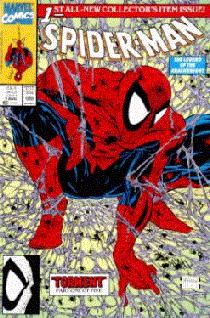
In 1990, an extremely popular artist named Todd McFarlane got his own
Spider-Man title to draw and write. The result was Spider-Man
#1 became the best-selling comic book to that date. Another reason why it
sold so well was that there were several different cover versions for this
issue. Lots of
fans went out and bought the same comic more than once to collect the
different covers. Some of them were shipped to the comic stores already
bagged for protection. Altogether there were 9 different versions of
Spider-Man #1. Some of them bagged, some of them in a different
color, some were second print, and even one was a platinum version.
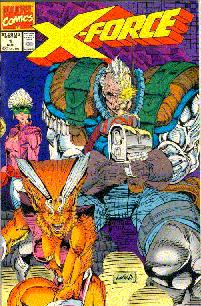
In 1991 Marvel would repeat this success, and create another
record-breaking comic book when they gave another very popular artist named
Rob Liefeld his own book to draw and plot. This book was called
X-Force #1. Like the Spider-Man book, this book had gimmicks
that would cause some fans to buy
several issues of the same comic. Different X-Force #1 issues had
different cards of the characters inside. Altogether there were 7 different
versions of this comic, 5 came with different cards, while others came
without a polybag wrapping or a second print of the comic.
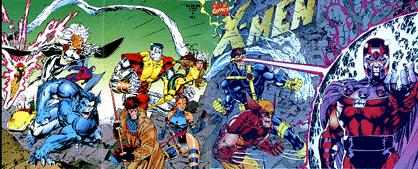
A third Marvel comic would repeat this success in the same year. This
was called X-men #1, by writer Chris Claremont and artist Jim Lee.
Once again a gimmick was used to ensure repeat sales of the same issue. This
comic came with 5 different covers, 4 of them making up one big cover
picture, and the fifth would have the whole picture all in one gatefold
cover. This comic would sell over 8 million issues
and remains the world's best-selling comic book.

In 1992 Superman died. Well, for a while he died. In
Superman #75 he was killed by a supervillain called Doomsday.
This event created major media attention. It also resulted in many mourners
around the world for Superman. Seven issues later (these were devoted
to his funeral and four characters who claimed to be the renewed or
reincarnated versions of Superman, such as 'Superboy'), in Superman
#82 the real one was brought back to life. Lo and behold, DC sold more
comics.
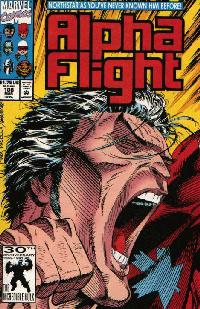
In Alpha Flight #106 The first mainstream gay superhero arrived,
or a better description would be that he 'came out of the closet.' The
character was called Northstar, and he was a member of a Canadian
team of superheroes called Alpha Flight. The bit of media attention
that this received caused
demand for the book to go up, and caused a bit of predictable controversy.
Another social issue was covered in the issue of The Incredible Hulk,
where a former supporting character became HIV positive. Since then Marvel
has stopped doing socially controversial stories.
The Image Age
Another very important event happened in 1992. This was the formation of
Image Comics. This company was started up by a group of disgruntled artists
and some artist/writers from Marvel comics. Their complaint was that they
were not given enough creative freedom in regards to new characters, or
enough editorial control over the new characters. So they left Marvel and
formed Image Comics. The new company would take the industry by storm with
high-quality artwork that had never been seen in a comic book. Another
improvement to comic art was computerized color separation. This new
technology would enhance the art several times over. The Image books were
printed on higher quality paper, which was better for those wishing to keep
their comic from degrading after a long period of time.
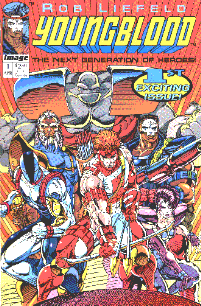
The group of people that left Marvel and formed Image were: Todd
McFarlane, Rob Liefeld, Jim Lee, Erik Larsen, Jim Valentino, Whilce Portacio, and Marc
Silvestri. Since then many others have joined, and some have left. The first
of their books to come out was Youngblood #1 by Rob Liefeld. This
comic is about a group of government-sponsored heroes who are together to
protect the world. Although Image is not popular with some long time
readers, Image has captured the attention of newer readers, and like
Marvel before them, they got some of their characters into cartoons and
movies only a few short years after they were started.
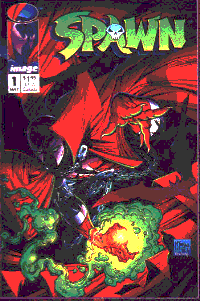
Spawn #1 is the best selling independent comic to date. It has a
cover date of May 1992 and it sold 1.7 million copies. This comic book was
created by Todd McFarlane, and it became the first book to consistently
outsell the popular comic titles of the big comic book companies. Since this
book, Todd has gone on to create his own toy company (against all advice)
for the purpose of making Spawn action figures. The company is now
called McFarlane Toys and it has made changes in the entire toy industry by
focusing on the design of the figure. Todd's goal is to make Spawn a
household name, like Superman or Spider-man. Currently there is a
Spawn cartoon for adults on HBO, and a Spawn movie in the
theaters. If this level of success continues, Todd may soon acheive his
goal.
In 1993 other companies started their own superhero comic lines. The two
main companies are Malibu and Dark Horse comics. Malibu had been a publisher
for Image comics when it was starting up, and was later bought by Marvel
Comics. Dark Horse had connections to Hollywood that would get them the
rights to do books on Hollywood characters like Robocop, Alien, Predator,
Star Wars, and Terminator. They would also succeed in getting
some of their superheroes on the big screen with characters such as The
Mask, Time Cop, and Barb Wire.
It was around this time that the "speculator" market died out. Because
many new comics were being over-hyped by the publishers, speculators and
fans alike bought several copies of certain comics only to find that the
expected future demand for the comic didn't materialize. Comics that were
promoted as the next "hot" book were no longer well-received by the majority
of comic readers. With the demand for over-hyped comics disappearing, the
speculators found they were unable to make any money. As well, some fans who
were also buying over-hyped comics and finding them unentertaining or worth
their dollars, also left the comic market.
In 1994-1996, Marvel made Peter Parker a clone of the original
true Spider-Man, causing Peter Parker to leave the guise of
Spider-Man and have a new character take over the superhero's role.
This angered fans so much Marvel comics had a 60% sales drop in their
Spider-Man titles. Marvel then did some reversing, and brought back
Peter Parker as the true wall-crawler in Spider-Man #75. This
is probably the most dramatic consumer back-lash to a storyline event for
such a popular character in recent years.

In 1994, DC tried to solve the mess that they created in Crisis of
the Infinite Earths, with another mini-series called Zero Hour.
At the end of this series, some previously "wiped out" time lines were
re-instated. As well,
a straight continuity was established. But there are still problems within
the DC Universe in figuring out what did and didn't happen.
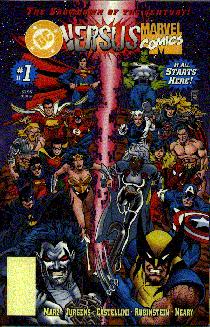
In 1996, DC and Marvel comics did a major crossover. This crossover
involves their characters fighting each other to see who would win, under
the conditions laid out in the books. Some of the winners were decided by
popular vote, both by post-office mail and E-mail, while others were decided
by the two companies. During this limited series Both Marvel and DC put out
a string of one-shot stories involving a weird merger of two of their
characters. An example would be Spider-Boy
(Spider-Man and Superboy combined) and Super Soldier
(Superman and Captain America combined).
Well, that's it for now. If you have any comments, questions, or (gulp)
corrections please E-mail me.
I am still missing cover pics of certain comics discussed above. If you
have any cover pics of some of these titles, or better pics than I currently
have for other titles, feel free to e-mail them to me as an attachment.
From here you can:
Sign my Guestbook
Read my Guestbook
Visit Mile High Comics
Check out my Links Page
See my sources of information and special
thanks.
Updates are announced on Digital Webbing.